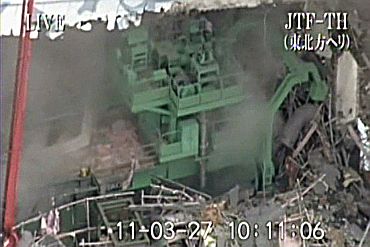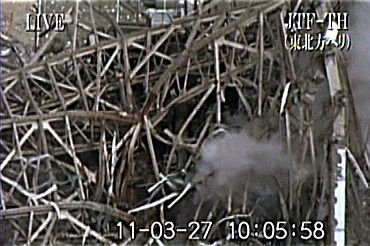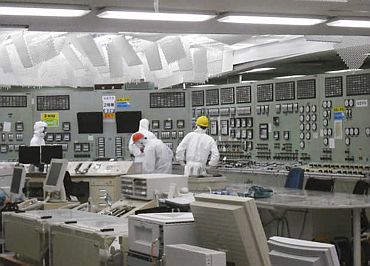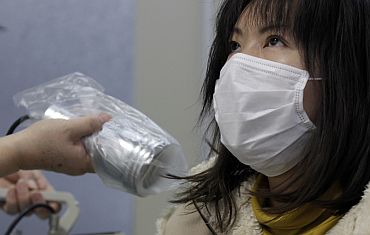This article was first published 14 years ago
Home »
News » High levels of radiation at Japan nuclear plant, workers evacuated
High levels of radiation at Japan nuclear plant, workers evacuated
Last updated on: March 27, 2011 12:18 IST
Image: A handout from Japan Ground Self-Defense Force via Kyodo shows smoke billowing from No. 3 reactor at Tokyo Electric Power Co.'s Fukushima Daiichi Nuclear Power Plant in Tomioka, Fukushima
Photographs: Kyodo/Reuters
Workers were evacuated from the tsunami-damaged Fukushima nuclear plant on Sunday after radiation levels surged 10 million times higher than usual, dealing a major blow to efforts to avoid a meltdown of the reactors.
The radiation in the water is 10 million times higher than that seen usually in the No 2 reactor complex, according Tokyo Electric Power Co, the operator of the plant, 250-km northeast of capital Tokyo.
"We are examining the cause of this, but no work is being done there because of the high level of radiation," said TEPCO, which later retracted the radioactivity result as it was taking another sample to get accurate levels.
It said the data for iodine-134 announced earlier in the day was actually for another substance that has a longer half-life.
Emergency workers trying to cool the nuclear plant were temporarily evacuated.
...

Image: A handout from Japan Ground Self-Defense Force via Kyodo shows No. 4 reactor at Tokyo Electric Power Co.'s Fukushima Daiichi Nuclear Power Plant
Photographs: Reuters
Hidehiko Nishiyama, spokesman for Japan's Nuclear and Industrial Safety Agency said the figure is "quite high". TEPCO has come in for criticism for for a lack of transparency and promptness in providing information. "We strongly urge TEPCO to provide information to the government more promptly," said Chief Cabinet Secretary Yukio Edano. He conceded that the progress was slow.
More than two weeks after the devastating quake and tsunami, leaving more than 27,000 people dead or unaccounted for, the government warned that the crisis was far from over.
"We'd like to be able to give a clear outline as to when this will be resolved, and those working at the site feel the same way," Edano was quoted as saying by NHK, the Japanese broadcaster.
Image: People work in the control room of reactor No 2 with restored lighting
Photographs: Reuters
The Vienna-based International Atomic Energy Agency, which has sent extra teams to the damaged plant, has also cautioned that the crisis could go on for months. "This is a very serious accident by all standards," Yukiya Amano, the director-general IAEA, was quoted as saying by the New York Times. "And it is not yet over."
"More efforts should be done to put an end to the accident," he said.
Adding to the concerns is the increasing level of radioactive iodine in the seawater near the plant, reaching 1,850.5 times the legal limit. On Friday, it was found to be 1,250.8 times the limit, the nuclear agency said.
Image: Japan Self Defense Force members in protective clothing prepare to transfer to another hospital workers who were exposed to radiation
Photographs: Reuters
The nuclear safety agency said there is no immediate threat to people within the 20-kilometer evacuation zone from the nuclear power plant. It said seawater is dispersed by ocean currents and the contamination level will decline.
TEPCO said it measured 2.9-billion becquerels of radiation per cubic cm of water from the basement of the turbine building attached to the Number 2 reactor, NHK reported.
The level of contamination is about 1,000 times that of the leaked water already found in the basements of the Number 1 and 3 reactor turbine buildings, it said.
Three workers at the No.3 reactor's turbine building, who were earlier exposed to contaminated water on March 24, are set to be discharged from medical care.
Image: Rie Imai, who was evacuated from Minamisoma in Fukushima, undergoes a test for signs of nuclear radiation at a health centre in Yonezawa
Photographs: Reuters
As part of efforts to bring the situation at the nuclear plant under control, TEPCO prepared to turn on the lights in the control room for the No. 4 reactor and inject fresh water into four reactors as a coolant, rather than sea
water.
It is seen as essential to prevent crystallized salt from seawater from hampering the smooth circulation of water and diminishing the cooling of the overheated fuel rods, Kyodo said.
Following the mega quake and tsunami, cooling functions failed at the No 1, No 2 and No 3 reactors and their cores partially melted.
Top officers of Japan's Self-Defense Forces and the US Pacific Fleet have agreed to share information on the troubled Fukushima plant and cooperate in solving the problem, NHK said.
The head of the SDF Joint Staff Office, General Ryoichi Oriki, and US Admiral Patrick Walsh met as American forces sent a vessel carrying a large amount of fresh water to cool the nuclear plant. Amid concerns over high level of radiation, Japan has banned shipments of foodstuffs grown in several prefectures around the damaged nuclear plant.
Source:
PTI© Copyright 2025 PTI. All rights reserved. Republication or redistribution of PTI content, including by framing or similar means, is expressly prohibited without the prior written consent.




